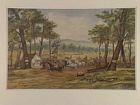To safely transport gold from the diggings to Melbourne and Geelong, gold escorts were established. With bushrangers and thieves roaming the roads, many miners paid – a shilling for each ounce of gold – for the government-run escort service to Melbourne, where they received higher prices for their gold than on the diggings. Much of the gold escorted, though, was the property of the government, and was revenue generated by licence fees. Once it reached Melbourne’s Treasury, most of the metal was shipped to England. When the gold reached its destination, owners reclaimed their deposits by showing a receipt, describing the gold, and by proving their identity. The last two steps were necessary as receipts were sometimes stolen, and the gold fraudulently claimed. If claimants couldn’t satisfy the three requirements the gold was forfeited to the government. A continual source of bitterness for miners, the government neither acknowledged liability, nor provided compensation, if the gold didn’t reach its destination.
Prior to the government escort service, gold was sent to Melbourne with the mail run. As the amount of gold dramatically increased, this service became too dangerous, and had insufficient capacity to cart the larger quantities, so more advanced systems were implemented. In September 1851, the first gold escort was established, from Ballarat to Melbourne’s Treasury, and Geelong. A month later, a second service was established from Mount Alexander. The first gold escort, from Ballarat to Geelong, comprised of a party of mounted police, two troopers, two Native Police and the Gold Commissioner. Yet this, too, soon proved inadequate. In July 1852, three tons of gold was escorted to Melbourne in seven drays, accompanied by seventeen soldiers on foot and six on horseback.
In March 1852, an escort service was established from Forest Creek to Adelaide, after the colony found itself dramatically short of funds. In the first year of the escort, a fifth of Victoria’s gold went to South Australia. In December 1853 escorts to Adelaide ceased, after eighteen runs.
Soon a few enterprising people followed the government’s lead and established private escort companies. For many miners, the government escort was unpopular. Not only did it refuse to guarantee the safe passage of the precious metal, and entail quite rigorous requirements to reclaim it, but also it was slow, travelling an average of only six kilometres an hour. In December 1851, the Melbourne Morning Herald foretold the future when it noted, ‘the Government will have to look sharp in improving their escorts, or this profitable branch of trade will soon pass into private hands. We are informed that it is the intention of one of the insurance companies to start an opposition escort to Mount Alexander, and guaranteeing the safe passage of the gold.’ In early 1852, Dight’s Private Gold Escort Company was established, consisting of twelve men. In June of that year, the Melbourne and Mount Alexander Escort Company was formed, and guaranteed the miner against loss.


